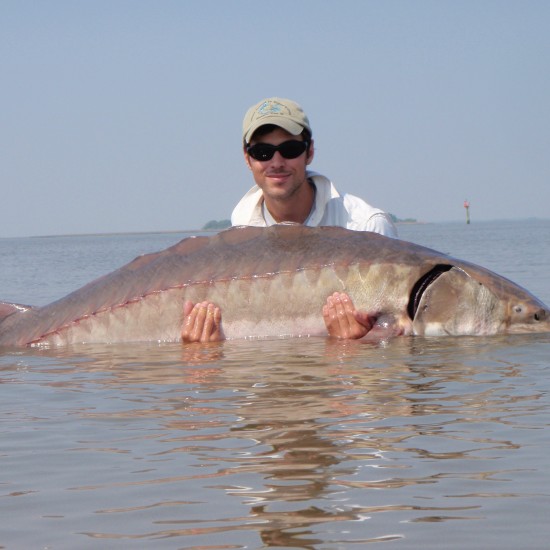The Atlantic sturgeon Acipenser oxyrinchus oxyrinchus (family Acipenseridae) is a large, long-lived fish that is broadly distributed along the Atlantic coast of North America. Historically, spawning populations occurred in virtually all major Atlantic Coast rivers from Ungava Bay, Canada to as far south as the St. Johns River, Florida (Vladykov and Greeley 1963; Dadswell 2006). In total, this historic range included approximately 38 individual rivers, 35 of which supported discrete spawning populations (ASSRT 2007). In 1996, all U.S. Atlantic sturgeon fisheries were closed (Smith and Clugston 1997) and the species was listed under the U.S. Endangered Species Act in 2012. At present, spawning populations are currently supported in less than 20 rivers (ASSRT 2007). The healthiest U.S. populations are currently thought to reside in the Hudson River, New York (Bain 1997), and the Altamaha River, Georgia (Schueller and Peterson 2010; Moyer et al. 2012), but the paucity of population assessments for other populations makes river-specific comparisons difficult (ASSRT 2007).
Atlantic sturgeon are strictly anadromous, using riverine, estuarine, and marine habitats throughout their range. Although the majority of their life history is spent in marine and coastal waters, mature adults will return periodically to freshwater rivers to spawn. These migrations are important to optimizing reproductive success by partitioning resources at different life stages and preventing intraspecific competition (Smith et al. 1982; Bain 1997). Despite decades of research, many knowledge gaps remain regarding the adult spawning migrations, particularly within the South Atlantic Distinct Population Segment (SA DPS).
Mark-recapture and telemetry studies have shown that spawning events are highly variable at both the population and individual levels (Bemis and Kynard 1997). Spawning occurs in the uppermost reaches of accessible river channels that are characterized by moderate flows of 46–76 cm/s and depths of 11–27 m (Smith and Clugston 1997; Bain et al. 2000). The adhesive eggs are broadcast over hard-bottom substrates composed of gravel and cobble (Gilbert 1989; Smith and Clugston 1997; Sulak et al. 2000). Previous studies, including both lab and field research, suggest that water temperatures of 13–25 °C are optimal for egg survival and hatching (Borodin 1925; Smith 1985; Kieffer and Kynard 1993; Hatin et al. 2002; Smith et al. 2015). Specific spawning sites have been identified in only a few river systems—mostly within the northern portion of the range (ASSRT 2007). South Carolina is the only southern state where potential spawning sites have been located (Collins et al. 2000). Most information regarding the timing of spawning was obtained from the Hudson River population, where spawning occurs from May–August (Bain 1997). A fall spawn, however, has been suggested to occur in several southern rivers (Smith and Dingley 1984; McCord et al. 2007), and studies have documented fall migrations in South Carolina (Collins et al. 2000) and Virginia (Balazik et al. 2012) rivers and wild-spawned eggs were collected during the fall in the Roanoke River, North Carolina (Smith et al. 2015).



